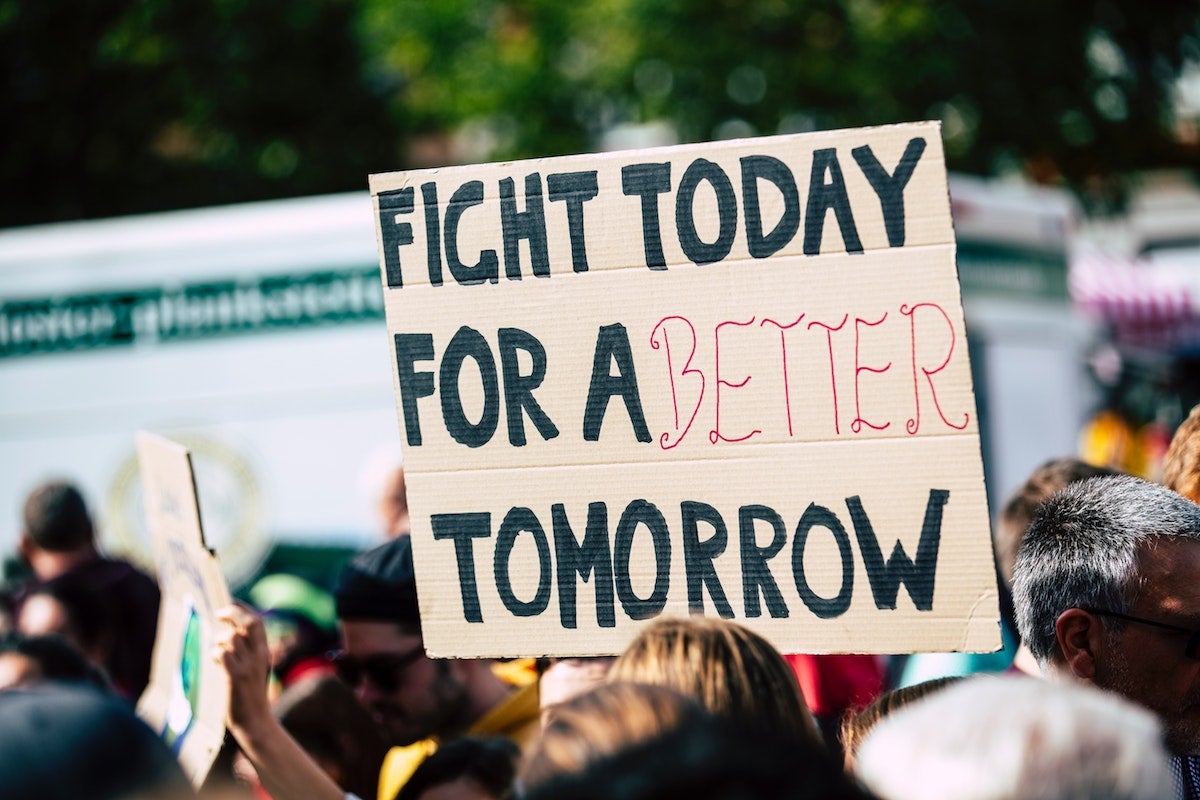Soon after George Floyd’s death and the worldwide protests demanding justice for Black lives and police-department reforms, Minneapolis’ city council announced June 7 it planned to disband their local force and invest in a community-based public-safety program.
As protests have continued nationwide, more than a dozen other U.S. cities, including Los Angeles, Dallas, and Washington, D.C., have also made commitments to reduce police resources and funding, and make changes to their systems.
Throughout American history, peaceful protesting — which is protected under the First Amendment and is an act of patriotism — has been utilized to advocate for and lead to change. While the overall impacts of the current national protests are still unfolding, they will likely be influential, just like these movements:
Boston Tea Party
Dec. 16, 1773
Boston, Massachusetts
The Boston Tea Party was the first significant act of rebellion by American colonist against the British. For years, colonists were unfairly taxed by the British government without representation in Parliament, and the Tea Act of 1773, which granted a monopoly and tax exemption to the British East Indian Company, was the final straw that caused American opposition.
Sixty men lead by the Sons of Liberty disguised themselves as Native Americans on Dec. 16, 1773, and threw 342 chests – 92,000 pounds – of tea into Boston Harbor. The protest was met with punishment from the British as Parliament passed punitive measures, such as closing Boston’s port until the debt from the Boston Tea Party was paid, and housing British troops in American homes, through the Intolerable Acts that aimed to target Massachusetts and divide the other colonies. Instead, it sparked the First Continental Congress in 1774 and led to the American Revolution, which began in Massachusetts in 1775 and ended in 1783 when the British formally recognized U.S. independence.
Women’s Suffrage Parade
March 3, 1913
Washington, D.C.
After 60 years of women fighting for suffrage, the first major demonstration for the cause took place during a parade on the eve of President Woodrow Wilson’s inauguration. The parade, organized by the National American Woman Suffrage Association and activist Alice Paul, consisted of more than 5,000 suffragettes, four mounted brigades, nine bands and 20 parade floats. During the march on Pennsylvania Ave, opposing spectators attacked demonstrators and police did not intervene, leading to injuries for more than 100 women.
The strategic timing of the parade helped revive attention around the movement, but it would take seven more years of protests, demonstrations and other tactics before the 19th amendment, which grants women the right to vote, was ratified on Aug. 18, 1920.
While women are guaranteed the right to vote under the Constitution, they are still fighting for protections under the Equal Rights Amendment, which was originally proposed in 1923 and has yet to be passed, but has made a recent resurgence that may eventually lead it to passing.
The March on Washington for Jobs and Freedom
Aug. 28, 1963
Washington, D.C.
About 250,000 people gathered near the Lincoln Memorial to voice their outrage against racial inequalities and the violent attacks of civil rights protestors at Birmingham, Alabama. It was at this march that Martin Luther King Jr. delivered his iconic “I Have a Dream” speech, which 3,000 members of the media were present to capture.
The idea for the march was actually born 22 years earlier in 1941 when civil rights leader and labor unionist A. Philip Randolph sought to organize a march that called out Black people’s exclusion from jobs created by World War II and President Franklin D. Roosevelt’s New Deal programs. A day before the march was scheduled, Roosevelt met with Randolph and issued an order banning discrimination against workers in government and defense jobs. He also established the Fair Employment Practice Committee to investigate racial discrimination in hiring practices and jobs. Five years later the committee was dissolved, and Randolph revived the idea for the march.
Years later, King and his Southern Christian Leadership Conference were planning a march for freedom, and Randolph and leaders from the NAACP were planning a march for jobs. The two groups joined forces for the 1963 march, after which King and other civil rights leaders discussed the need for a strong civil rights bill with President John F. Kennedy and Vice President Lyndon B. Johnson. This led enaction of the Civil Rights Act of 1964 and it, along with the Selma-to-Montgomery, Alabama, marches, also led to the Voting Rights Act of 1965.
Stonewall Riots
June 28 to July 3, 1969
New York
In the 60s, raids on local gay bars and harassment to patrons by the New York Police Department were common. But when officers raided the Stonewall Inn in Greenwich Village on the morning of June 28, 1969, members of the LGBTQ community had enough and resisted. Protests began that same morning and continued for six days, marking a monumental moment that has inspired decades of activism within the LGBTQ+ community.
Prior to Stonewall, there were no legal protections for the LGBTQ community, and since 1952 being gay had been listed as a mental illness in the American Psychiatric Association’s Diagnostic and Statistical Manual.
Leaders for the Stonewall Riots, including gay-liberation activists and drag queens Marsha P. Johnson and Sylvia Rivera, formed organizations, such as the Gay Liberation Front, after the event that pushed for policy changes and social inclusivity for the LGBTQ community. One year after the historic riots, the first Christopher Street Liberation Day march, which is named after Stonewall Inn’s location, was organized in New York and other U.S. cities. This march would lead to a rise in annual Pride events worldwide. In 1973, the psychiatric association removed homosexuality from its diagnostic manual.
Since the ‘90s, the Supreme Court has established several landmark rulings that have put protections in place for and removed discriminatory laws against the LGBTQ community. These include decriminalizing homosexual behavior, legalizing gay marriage and, as recently as June 15, making it illegal to fire employees for their sexual orientation or gender identities.
Occupation of Alcatraz
Nov. 20, 1969, to June 11, 1971
San Francisco Bay, California
In 1934, the U.S. government began using Alcatraz Island to house prisoners before closing the island’s prison in 1963. The following year, it was declared a federal surplus property and soon thereafter Native American activists began occupying the island, citing the Fort Laramie Treaty of 1868, an agreement that states Native Americans could claim unused federal lands.
In November 1969, 89 members from Indians of All Tribes began living on the island and continued their protest for 19 months. Their initial demands were to build Native Indian institutions on the island, partly due to a fire a month prior that destroyed the San Francisco Indian Center, which helped provide jobs, health care, legal aid, and other opportunities. While on Alcatraz, the protestors, which included 400 people at its height, lived without running water, phone service and, for some time, electricity. Some Native Americans spoke out and said these, and worse, conditions were already in place on reservations.
U.S. authorities forcibly ended the occupation in June 1971 when police and federal agents removed the 15 remaining protestors. And while the initial demands were not met, the protest brought attention to the Indian Termination Policy, which began in the mid-1940s. That was series of laws and policies that aimed to abolish Native American tribes and culture in order to forcibly assimilate them into American society, making them tax-paying citizens and removing federal and state exemptions they were granted. During the Occupation of Alcatraz, President Richard Nixon ended the policy in 1970 and the publicity around the event led to a new policy of self-determination for Native Americans.
The March for Our Lives
March 24, 2018
Washington, D.C., with other protests led worldwide.
On Feb. 14, 2018, 17 people at Marjory Stoneman Douglas High School in Parkland, Florida, were killed by a former student who opened fire with a semi-automatic rifle. The tragedy marked a turning point in years of calls for gun-control legislation and led to the March for Our Lives the next month.
The march in Washington, D.C., was organized by students who survived the shooting and gathered 800,000 people. Affiliated protests across the United States brought the total national turnout to an estimated 1.2 million to 2 million. There were also other protests held around the globe.
Before the Stoneman Douglas shooting, Florida’s gun laws were some of the weakest in America. But in March 2018, the Marjory Stoneman Douglas High School Public Safety Act was passed by the state legislature and implemented changes such as raising the minimum age for gun purchases from 18 to 21, increasing waiting periods until background checks clear or three days, whichever is longer, among other measures. Florida, along with 16 other states and Washington, D.C., have enacted red-flag laws, which allow for the temporary removal of firearms if someone poses a danger to themselves or others. Bump stocks, which increase firing power of semiautomatic weapons, also have been banned nationally.
Protests
July 14 to July 24, 2019
Puerto Rico
After years of sluggish progress to recover from Hurricane Maria and many more years of alleged corruption within the Puerto Rican government, a scandal involving the island’s governor and his staff led to national outrage and calls for resignation.
On July 13, 2019, hundreds of pages of messages between Puerto Rico’s Gov. Ricardo Rosselló and his staff containing racist, homophobic and vulgar language to ridicule politicians, journalists and celebrities were publicly leaked. The messages, which were sent through the Telegram messaging app, also stated they would use the media to target political opponents. Days before the leak, the island’s education secretary and the head of the health were arrested by the FBI on corruption charges.
Rosselló publicly apologized soon after, and said he would not resign, although members of his cabinet did. On July 14, 2019, protests began outside his home and continued for weeks as police guarded the home and often used tear gas. The protests spread and intensified, even resulting in a shutdown of a major highway and a strike across the island.
On July 24, 2019, Rosselló announced his resignation effective Aug. 2 of that year. On Aug. 7, 2019, Wanda Vázquez Garced became governor of Puerto Rico.





